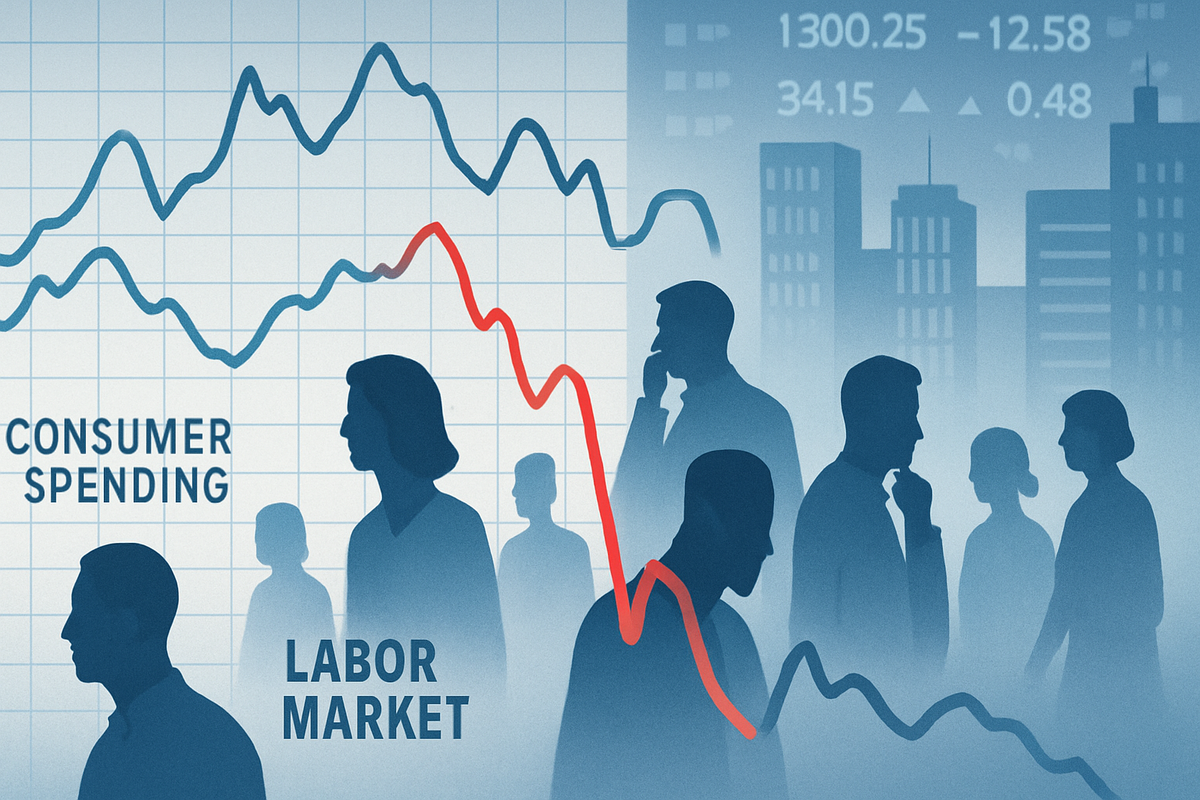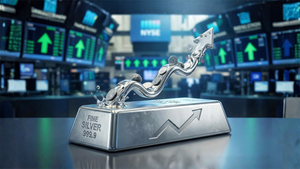
The global financial landscape is currently navigating a period of heightened uncertainty, with key economic indicators signaling a notable deceleration in private consumption and emerging fragilities within the labor market. These intertwined trends are casting a long shadow over the stock market, prompting investors to re-evaluate their positions and brace for potential shifts in corporate earnings and overall economic resilience. The coming weeks, particularly with the release of crucial retail earnings reports, are expected to offer a clearer, more definitive picture of consumer health and the broader economic trajectory.
Economic Headwinds Gather: Consumption Slows, Labor Market Cools
The current economic climate is marked by a significant slowdown in private consumption, a critical engine of economic growth, particularly in the United States where it accounts for nearly 70% of the Gross Domestic Product (GDP). Data from the first half of 2025 reveals a concerning trend: real personal consumption expenditures (PCE) saw an annual increase of only 1.2% in the first quarter of 2025, a stark contrast to the robust 4% growth recorded in the preceding quarter of 2024. The most pronounced decline was observed in spending on durable goods, which plummeted by 3.8% in Q1 2025 after a strong 12% rise. While Q2 2025 showed a slight improvement to 1.4% from 0.5% in Q1, this still represents the tamest consecutive quarterly growth since the onset of the pandemic. This pullback in consumer spending is closely linked to a decline in consumer sentiment, which remains notably lower than levels seen in 2024, suggesting that a sharp rebound in consumption is unlikely in the near term.
Concurrently, the labor market is exhibiting clear signs of cooling, raising concerns about its underlying strength. Recent job growth figures indicate a significant slowdown, with the three-month average job gain at 81,000, a considerable drop from the 115,000 (six-month average) and 139,000 (twelve-month average) observed previously. May's Jobs Report, while initially showing 139,000 jobs added, is subject to potential downward revisions, a pattern seen in previous months of 2025. The private sector, in particular, struggled in May, with ADP reporting a mere 37,000 new jobs, marking the slowest hiring pace since March 2023.
Further indicators underscore the weakening labor market. Unemployment rates for specific demographic groups are on the rise, with individuals aged 20-24 experiencing an 8.2% unemployment rate in April, the highest three-month average since mid-2021. The labor market for Black workers has also shown signs of weakening, with their unemployment rate hitting 6.3% in April, up from an all-time low of 4.8% in April 2023. Wage growth is also decelerating, with the year-over-year rate falling to 3.8% in March and April, and the annualized rate over the last three months at just 2.6%. Job openings have fallen to 7.7 million in July, their lowest level since January 2021, and both hires and quits rates are now below their pre-pandemic averages. Initial jobless claims have risen to their highest level since October, and continuing unemployment claims have exceeded 1.9 million. Job cut announcements in May surged by nearly 50% compared to the same month last year, and are 80% higher for the first five months of this year compared to 2024. Sector-specific weaknesses are also evident, with declines in federal government employment and retail sales, alongside stagnation in manufacturing and construction employment. A senior central bank official has even acknowledged "signs of fragility" in the labor market, advocating for interest rate cuts to prevent further deterioration.
Navigating the Shifting Tides: Potential Winners and Losers
The current economic environment, characterized by slowing consumer spending and a cooling labor market, is creating a distinct divide between potential winners and losers in the stock market. Companies with strong balance sheets, resilient business models, and those less reliant on discretionary consumer spending may weather the storm more effectively, while others face significant headwinds.
Companies in the consumer discretionary sector are likely to face the brunt of slowing private consumption. Retailers, particularly those selling big-ticket items like electronics, furniture, and automobiles, are vulnerable. Companies such as Amazon.com (NASDAQ: AMZN), while diversified, could see a slowdown in their e-commerce segments if consumer confidence continues to wane. Similarly, traditional brick-and-mortar retailers like Target Corporation (NYSE: TGT) and Walmart Inc. (NYSE: WMT) might experience reduced foot traffic and lower sales volumes, impacting their earnings. Travel and leisure companies, including airlines like Delta Air Lines, Inc. (NYSE: DAL) and cruise lines such as Carnival Corporation & Plc (NYSE: CCL), could also see reduced demand as consumers tighten their belts and prioritize essential spending over leisure activities.
Conversely, companies in the consumer staples sector, which provide essential goods and services, tend to be more resilient during economic downturns. Firms like Procter & Gamble Co. (NYSE: PG), Coca-Cola Company (NYSE: KO), and PepsiCo, Inc. (NASDAQ: PEP) are likely to see more stable demand for their products, as consumers will continue to purchase food, beverages, and household necessities regardless of economic conditions. Additionally, healthcare companies, such as Johnson & Johnson (NYSE: JNJ) and UnitedHealth Group Incorporated (NYSE: UNH), often demonstrate defensive characteristics, as healthcare spending is less discretionary. Companies offering value-oriented products or services may also find themselves in a relatively stronger position, as consumers seek more affordable alternatives. Discount retailers and certain private label brands could see increased demand. Furthermore, companies with strong dividend yields and a history of consistent payouts might become more attractive to investors seeking stability and income in a volatile market.
Broader Implications and Industry Ripple Effects
The observed slowdown in consumer spending and the cooling labor market are not isolated incidents but rather integral components of broader economic trends with significant ripple effects across various industries. This scenario fits into a larger narrative of potential economic deceleration following a period of robust post-pandemic growth, exacerbated by persistent inflationary pressures and tighter monetary policies.
The most immediate ripple effect will be felt by industries directly tied to consumer demand. Beyond retail, the manufacturing sector will likely experience reduced orders as consumer demand for goods softens, impacting companies like General Electric Company (NYSE: GE) or Caterpillar Inc. (NYSE: CAT) if industrial demand also slows. The housing market, already sensitive to interest rates, could face further headwinds as job insecurity and reduced consumer confidence deter potential homebuyers, affecting real estate developers and related industries. The financial sector, including banks like JPMorgan Chase & Co. (NYSE: JPM) and Bank of America Corporation (NYSE: BAC), could see a rise in loan defaults and a slowdown in lending activity if unemployment rises and economic conditions worsen.
From a regulatory and policy standpoint, these trends put increased pressure on central banks, particularly the Federal Reserve, to carefully calibrate monetary policy. A slowing labor market often correlates with lower inflation, potentially providing the Fed with room to implement more aggressive interest rate cuts to stimulate the economy. However, a significant market risk arises if inflation remains elevated despite weaker job growth, forcing the Fed to maintain higher interest rates while the economy slows—a challenging "stagflationary" scenario. Historically, periods of significant consumer spending slowdowns coupled with labor market weakening have often preceded or coincided with economic recessions. Comparisons can be drawn to the periods leading up to the 2008 financial crisis or even earlier downturns, where a contraction in consumer confidence and employment signaled broader economic distress. While the current situation may not mirror past crises exactly, the underlying dynamics of reduced demand and employment fragility are consistent warning signs. The impact of tariffs and policy uncertainty also looms large, with the potential to disrupt business confidence, hiring, investment, and consumer spending, further complicating the economic outlook.
What Comes Next: Navigating the Economic Crossroads
The coming months will be critical in determining the trajectory of the U.S. economy and, by extension, global markets. Short-term, the focus will heavily shift to upcoming retail earnings reports, which will provide granular insights into consumer health. Companies like Walmart Inc. (NYSE: WMT), Target Corporation (NYSE: TGT), and various apparel and electronics retailers will offer a clearer picture of how the slowdown in private consumption is translating into corporate performance. Any significant misses or cautious outlooks from these bellwether companies could trigger further market volatility and reinforce concerns about a broader economic downturn.
In the long term, the interplay between monetary policy and economic data will be paramount. Should the labor market continue to weaken and inflation show sustained signs of cooling, the Federal Reserve may be compelled to accelerate interest rate cuts. This could provide a much-needed stimulus to the economy, potentially easing borrowing costs for businesses and consumers and encouraging investment and spending. However, if inflation proves sticky despite a slowing economy, the Fed will face a difficult balancing act, potentially prolonging the period of economic uncertainty. Businesses will need to adapt strategically, focusing on cost efficiencies, optimizing supply chains, and potentially diversifying revenue streams to mitigate the impact of reduced consumer demand. Companies with strong cash reserves and flexible operations will be better positioned to navigate these challenges.
Market opportunities may emerge in defensive sectors, such as consumer staples, utilities, and healthcare, which tend to be more resilient during economic downturns. Investors might also look for companies with strong international exposure that can offset domestic weakness, or those with innovative products or services that can capture market share even in a challenging environment. Conversely, challenges will persist for highly cyclical industries and those heavily reliant on discretionary spending. Potential scenarios range from a "soft landing," where the economy slows but avoids a severe recession, to a more pronounced downturn if current trends accelerate. The key will be the responsiveness of policymakers and the adaptability of businesses to the evolving economic landscape.
Conclusion: A Vigilant Eye on Economic Barometers
The current economic landscape, characterized by a discernible slowdown in private consumption and emerging weaknesses in the labor market, represents a critical juncture for the financial markets. The immediate implications point to increased market volatility and a re-evaluation of corporate earnings expectations, particularly for consumer-facing sectors. The detailed coverage of these trends highlights that the deceleration is not merely anecdotal but supported by concrete data, from declining durable goods spending to rising jobless claims and slowing wage growth.
Moving forward, investors must maintain a vigilant eye on these economic barometers. Key takeaways include the heightened sensitivity of the stock market to labor market reports, the potential for shifts in investor behavior towards safer assets, and the complex policy challenges facing the Federal Reserve. The upcoming retail earnings reports will serve as crucial real-time indicators of consumer health, offering a more granular understanding of how these macroeconomic trends are impacting corporate bottom lines.
The significance of these developments extends beyond immediate market fluctuations; they underscore the delicate balance required to manage economic growth, inflation, and employment. What investors should watch for in the coming months includes the pace of job creation and unemployment rates, consumer sentiment surveys, and, critically, the Federal Reserve's commentary and actions regarding interest rates. The ability of the economy to achieve a "soft landing" will largely depend on the interplay of these factors and the effectiveness of policy responses. The lasting impact of this period will be determined by how quickly and effectively businesses and policymakers adapt to the evolving economic realities, shaping the investment landscape for years to come.





